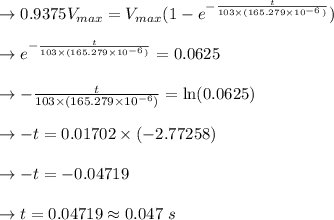
1/2 means that the voltage (or charge) of the system will increase to half more of what is left in a time equal to t1/2 seconds. Therefore if a system is already at half charge (t1/2 seconds after starting) then after t1/2 more seconds the system will be charged to 50% plus half of 50%. That is 25% more, or 75% of the entire charge. Let's say that four t1/2's have gone by. That means that the charge (or voltage) is at (50% + 1/2*50% + 1/2*1/2*50% + 1/2*1/2*1/2*50%) = 93.75% of maximum charge. Yikes! Now look in your manual for a more simple mathematical derivation of this concept. Given t1/2 to be 0.4406 seconds, how long should it take to reach 75% of maximum charge? answer in seconds.

Answers: 1


Another question on Physics

Physics, 21.06.2019 20:00
Which sentences describe disadvantages of burning fossil fuels instead of using hydrogen fuel cells? burning fossil fuels contributes to climate change. burning fossil fuels takes place inside expensive fuel cells. fossil fuels aren't widely available, but pure hydrogen is. fossil fuels are nonrenewable.
Answers: 1

Physics, 22.06.2019 14:30
Which pair of quantities includes one quantity that increases as the other decreases during simple harmonic motion?
Answers: 1

Physics, 22.06.2019 15:30
To understand the behavior of the electric field at the surface of a conductor, and its relationship to surface charge on the conductor. a conductor is placed in an external electrostatic field. the external field is uniform before the conductor is placed within it. the conductor is completely isolated from any source of current or charge. part a: which of the following describes the electric field inside this conductor? it is in the same direction as the original external field.it is in the opposite direction from that of the original external field.it has a direction determined entirely by the charge on its surface.it is always zero. part b: the charge density inside the conductor is: 0non-zero; but uniformnon-zero; non-uniforminfinite part c: assume that at some point just outside the surface of the conductor, the electric field has magnitude e and is directed toward the surface of the conductor. what is the charge density η on the surface of the conductor at that point? express your answer in terms of e and ϵ0
Answers: 1

Physics, 22.06.2019 22:00
Ne way in which elements differ from each other is the structure of the electron cloud in each element's atoms. in an electron cloud, an electron that is farther away from the nucleus has
Answers: 1
You know the right answer?
1/2 means that the voltage (or charge) of the system will increase to half more of what is left in a...
Questions









Mathematics, 03.08.2021 19:00

Biology, 03.08.2021 19:00



History, 03.08.2021 19:00


English, 03.08.2021 19:00










